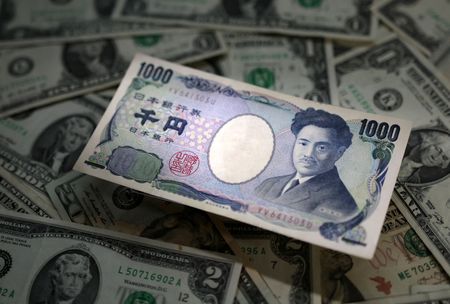
By Joice Alves and Rae Wee
LONDON/SINGAPORE (Reuters) – The yen fell to a new 15-year low against the euro on Friday after the Bank of Japan (BOJ) kept ultra-low interest rates and forecast that inflation will slow later this year in contrast with the European Central Bank’s (ECB) rate hike on Thursday.
As widely expected, the BOJ maintained its -0.1% short-term interest rate target and a 0% cap on the 10-year bond yield set under its yield curve control (YCC) policy.
“We expect inflation to moderate, but it’s true the pace of decline is somewhat slow. But we’re still in the early stages of the moderation. There’s uncertainty on whether the future slowdown will be a gradual one, or a quite sharp one,” BOJ Governor Kazuo Ueda said.
The yen fell broadly following the decision and hit a fresh 15-year low of 154.70 per euro, down 0.7% on the day. It was set for the biggest weekly decline against the single currency in three year.
Against the U.S. dollar, the Japanese currency fell 0.6% to 141.22 yen.
“While the decision itself was not a major surprise, a few participants … had expected a YCC adjustment, and the financial market reacted with higher stock prices and a weaker yen,” said Hirofumi Suzuki, chief FX strategist at SMBC.
Elsewhere, the euro was poised for its best week in three months after the ECB raised borrowing costs to a 22-year high and signalled further rate hikes to come.
That and some soft U.S. economic data saw the dollar fall broadly as traders scaled back their bets on how high U.S. interest rates would need to rise.
The euro flattened at $1.0951 after rising to a one-month high against the dollar, having surged over 1% on Thursday following the rate hike and forward guidance from the ECB.
ECB President Christine Lagarde told a news conference that another rate hike in July was highly likely and that the central bank still has “ground to cover” to stave off high inflation.
Sterling edged 0.1% higher at $1.2793 after rising to its highest level since April 2022 as traders similarly ramped up bets that the Bank of England is likely to raise interest rates for the 13th meeting in a row next week.
FED FACES GRIM DATA
The ECB’s monetary policy decision came a day after the U.S. Federal Reserve left interest rates unchanged, snapping a string of 10 consecutive rate hikes. However, the Fed also signalled that borrowing costs may still need to rise by as much as half of a percentage point by the end of this year.
But a string of data on Thursday had markets challenging that view, as economic activity in the United States slows and inflation cools.
Production at U.S. factories almost stalled in May as manufacturing struggled under the weight of higher interest rates, while U.S. import prices similarly fell last month.
A separate report from the Labor Department showed initial claims for state unemployment benefits were unchanged at a seasonally adjusted 262,0000 for the week ended June 10, above economists’ forecast for 249,000 claims.
U.S. retail sales unexpectedly rose in May, however, as consumers stepped up purchases of motor vehicles and building materials.
Against a basket of currencies, the dollar index edged up 0.1% to 102.25, after slipping to a one-month low on Thursday.
(Reporting by Joice Alves in London and Rae Wee in Singapore; Editing by Philippa Fletcher)
